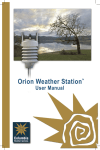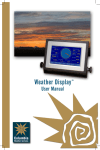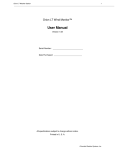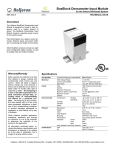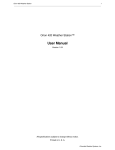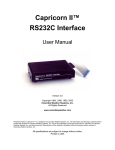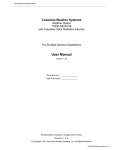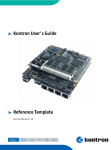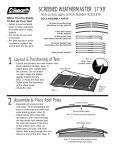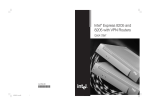Download Open Pulsar User Manual PDF
Transcript
Pulsar Weather Station 1 ___________________________________________________________________ Pulsar Weather Station™ User Manual Version 1.10 Serial Number: ___________________ Date Purchased: __________________ All specifications subject to change without notice. Printed in U. S. A. Columbia Weather Systems, Inc. 2 Pulsar Weather Station ____________________________________________________________________ © Copyright 2015 Columbia Weather Systems, Inc. All Rights Reserved. Proprietary Notice: Pulsar Weather Station, Orion Weather Station, Orion LX Weather Station, Capricorn 2000 Weather Station, Capricorn 2000MP Weather Station, Capricorn 2000EX Weather Station, Magellan Weather Station, Vela Weather Station and Weather MicroServer are trademarks of Columbia Weather Systems, Inc. The information and drawings contained herein are the sole property of Columbia Weather Systems, Inc. Use of this publication is reserved exclusively for customers of Columbia Weather Systems, Inc. and their personnel. Reproduction of this material is forbidden without the express written consent of Columbia Weather Systems, Inc. Columbia Weather Systems, Inc. Pulsar Weather Station 3 ___________________________________________________________________ Welcome! Congratulations on your purchase of a Pulsar Weather Station. Please read this manual completely prior to installation. Columbia Weather Systems, Inc. 4 Pulsar Weather Station ____________________________________________________________________ Columbia Weather Systems, Inc. Pulsar Weather Station 5 ___________________________________________________________________ Important Notice: Shipping Damage BEFORE YOU READ ANY FURTHER, please inspect all system components for obvious shipping damage. The Pulsar is a high precision instrument and can be damaged by rough handling. Your unit was packaged to minimize the possibility of damage in transit. Please save the shipping container for any future shipment of your Pulsar sensor. In the event your order arrives in damaged condition, it is important that the following steps be taken immediately. The title transfers automatically to you, the customer, once the material is entrusted to the transport company. NOTE: DO NOT RETURN THE INSTRUMENT TO COLUMBIA WEATHER SYSTEMS until the following steps are completed. Failure to follow this request will jeopardize your claim. 1. Open the container and inspect the contents. Do not throw away the container or any damaged parts. Try to keep items in the same condition as originally received. 2. Notify the transport company immediately. 3. Request the transport company’s representative inspect the shipment personally. 4. After inspection, request a Return Materials Authorization (RMA) from Columbia Weather Systems by calling (503) 629-0887. 5. Return approved items to us at the following address: Columbia Weather Systems, Inc. 5285 NE Elam Young Parkway, Suite C100 Hillsboro, OR 97124 6. After a repair evaluation, an estimate of the cost of repair will be sent to you. Columbia Weather Systems, Inc. 6 Pulsar Weather Station ____________________________________________________________________ ESD Protection Electrostatic Discharge (ESD) can cause immediate or latent damage to electronic circuits. The Pulsar is adequately protected against ESD for its intended use. However, it is possible to damage the product by delivering electrostatic discharges when touching, removing, or inserting any objects inside the equipment housing. To avoid delivering high static voltages yourself: 1. Handle ESD sensitive components on a properly grounded and protected ESD workbench. When this is not possible, ground yourself with a wrist strap and a resistive connection cord to the equipment chassis before touching the boards. When neither of the above is possible, at least touch a conductive part of the equipment chassis with your other hand before touching the boards. 2. Always hold the boards by the edges and avoid touching the component contacts. Columbia Weather Systems, Inc. Pulsar Weather Station 7 ___________________________________________________________________ Table of Contents WELCOME! ..................................................................................3 IMPORTANT NOTICE: SHIPPING DAMAGE .......................5 ESD PROTECTION ............................................................................................. 6 SECTION 1: INTRODUCTION ................................................11 THE PULSAR WEATHER STATION ................................................................... 11 SPECIFICATIONS .............................................................................................. 12 Operating Conditions................................................................................. 12 Wind Speed ................................................................................................ 12 Wind Direction ........................................................................................... 12 Relative Humidity....................................................................................... 12 Temperature ............................................................................................... 12 Barometric Pressure .................................................................................. 13 Precipitation .............................................................................................. 13 Compass ..................................................................................................... 13 Solar Radiation (501 Model) ..................................................................... 13 Input Voltage.............................................................................................. 14 Heating....................................................................................................... 14 Heating Power Source ............................................................................... 14 Power Consumption (without heating) ...................................................... 14 Power Consumption (@ 24VDC - with heating)........................................ 15 Dimensions & Weights ............................................................................... 15 Sensor Housing .......................................................................................... 15 PRINCIPLES OF MEASUREMENTS ..................................................................... 16 Temperature & Relative Humidity ............................................................. 16 Wind Speed & Direction ............................................................................ 16 Barometric Pressure .................................................................................. 16 Precipitation .............................................................................................. 16 Compass ..................................................................................................... 16 Solar Radiation (Model 501 Only)............................................................. 17 Ventilation Fan: ......................................................................................... 17 SECTION 2: PHYSICAL DESCRIPTION ...............................19 PULSAR SENSOR TRANSMITTER ...................................................................... 19 Pulsar 200 .................................................................................................. 20 Pulsar 500 .................................................................................................. 21 Pulsar 501 .................................................................................................. 22 Pulsar 600 .................................................................................................. 23 Pulsar 601 .................................................................................................. 24 INTERFACE MODULE ...................................................................................... 25 SURGE/LIGHTNING PROTECTOR...................................................................... 26 Columbia Weather Systems, Inc. 8 Pulsar Weather Station ____________________________________________________________________ WEATHER MICROSERVER (REQUIRED) .......................................................... 27 WEATHERMASTER SOFTWARE (OPTIONAL) ................................................ 28 WEATHER DISPLAY CONSOLE (OPTIONAL) .................................................... 29 SECTION 3: SYSTEM CONFIGURATIONS..........................31 Cabled System COM2 Connection ............................................................. 31 Cabled System COM1 Connection ............................................................. 32 System with Weatherproof Enclosure ........................................................ 33 SECTION 4: INSTALLATION .................................................37 INSTALLATION OVERVIEW.............................................................................. 37 UNPACKING THE UNIT .................................................................................... 37 Installing the Mast ..................................................................................... 39 Location ..................................................................................................... 39 Mounting Method ....................................................................................... 39 Routing Cable ............................................................................................ 39 Installing the Pulsar Sensor Transmitter ................................................... 41 Site Selection .............................................................................................. 41 Sensor Mounting Hardware ....................................................................... 41 Mounting Adapter ...................................................................................... 42 Installation Procedure ............................................................................... 42 North Alignment – Integrated Electronic Compass ................................... 43 Manual North Alignment (Optional Procedure) ........................................ 43 Installing the Surge Arrestor...................................................................... 45 Connecting the Sensor Transmitter to the Interface Module ..................... 46 OPTIONAL SENSOR MOUNTING HARDWARE ................................................... 47 Tripod and Tiedown Kit ............................................................................. 47 Specifications ............................................................................................. 49 Sensor Mast................................................................................................ 49 Roof Mounting ........................................................................................... 49 Wall Mounting ........................................................................................... 51 SECTION 5: CALIBRATION....................................................53 FACTORY CALIBRATION AND REPAIR SERVICE .............................................. 53 SECTION 6: MAINTENANCE .................................................55 CLEANING....................................................................................................... 55 SECTION 7: TROUBLESHOOTING .......................................57 Loss of communication with Pulsar sensor transmitter: ............................ 58 SECTION 8: USER SUPPORT INFORMATION ...................59 LIMITED WARRANTY ...................................................................................... 59 EXCLUSIONS ............................................................................................ 59 RETURN FOR REPAIR PROCEDURE .................................................................. 61 Columbia Weather Systems, Inc. Pulsar Weather Station 9 ___________________________________________________________________ REFERENCE ...............................................................................63 GLOSSARY ...................................................................................................... 63 Aspirating Radiation Shield ....................................................................... 63 Barometric Pressure .................................................................................. 63 Celsius Temperature Scale......................................................................... 63 Dew Point .................................................................................................. 63 Density Altitude.......................................................................................... 63 Fahrenheit Temperature Scale................................................................... 63 Global Radiation........................................................................................ 64 Heat Index .................................................................................................. 64 Pyranometer............................................................................................... 64 Relative Humidity....................................................................................... 64 Sea Level Pressure ..................................................................................... 64 Solar Radiation .......................................................................................... 64 Wind Chill .................................................................................................. 64 UNIT CONVERSION ......................................................................................... 65 Speed .......................................................................................................... 65 Temperature ............................................................................................... 65 Distance ..................................................................................................... 65 Pressure ..................................................................................................... 65 TABLES AND FORMULAS ................................................................................. 66 Wind Chill Chart ........................................................................................ 66 Wind Chill Equation .................................................................................. 67 Heat Index .................................................................................................. 68 Dew Point .................................................................................................. 69 Columbia Weather Systems, Inc. 10 Pulsar Weather Station ____________________________________________________________________ Columbia Weather Systems, Inc. Pulsar Weather Station 11 ___________________________________________________________________ SECTION 1: INTRODUCTION The Pulsar Weather Station The Pulsar is a highly accurate weather station designed around an allin-one sensor module and the Weather MicroServer. The Weather MicroServer is available for Ethernet connectivity, Modbus/TCP, Modbus RTU and SNMP interface, Weather Underground, Anything Weather and CWOP interface, XML weather data, and FTP. Please see the MicroServer user manual for more information. Columbia Weather Systems, Inc. 12 Pulsar Weather Station ____________________________________________________________________ Specifications Operating Conditions Temperature Operation: -58 to +140°F (-50 to +60°C) Relative humidity: 0 - 100% Wind Speed Range: 0-167 mph (0 - 75 m/s) (WS 601: 0 - 67 mph (0 - 30 m/s)) Accuracy: ±0.67 mph (0.3 m/s) or ±3% (0 - 78 mph) (0 - 35 m/s) ±5% (>78mph) Resolution: 0.2 mph (0.1 m/s) Units Available: knots, mph, km/hr, m/s Wind Direction Measurement Range: 0-360° Accuracy: < 3° (>1 m/s) Resolution: 0.1° Response threshold: 0.01 mph (0.3 m/s) Units Available: degrees Relative Humidity Range: 0 - 100% Accuracy: ±2% RH Resolution: 0.1% RH Units Available: %RH Temperature Range: -58 to 140°F (-50 to +60°C) Accuracy: ±0.36°F (-4 to 122°F) otherwise ±0.9°F (> -22°F) Resolution: 0.18°F (-4 to 122°F) otherwise 0.36°F Units Available: °F, °C Columbia Weather Systems, Inc. Pulsar Weather Station 13 ___________________________________________________________________ Barometric Pressure Range: 8.85 - 35.4 inHg (300 - 1200 hPa) Accuracy: ±0.015 inHg (0.5 hPa) (32 to 104°F) Resolution: 0.003 inHg (0.1 hPa) Units Available: kPa, hPa, mbar, inHg Precipitation Doppler Radar (600 Model) Measurement Range (drop size): (0.01-0.2 in) (0.3 - 5 mm) Resolution: 0.0004 in (0.01 mm) Precipitation types: Rain, snow Reproducibility: Typical > 90% Response threshold: 0.01mm Units Available: mm, inches Tipping Bucket Rain Gauge (601 Model) Resolution: 0.2 mm / 0.5 mm Accuracy: ±2% Precipitation type: Rain Units Available: mm, inches Compass Measurement Range: 0-359° Resolution: 1.0° Sampling rate: 5 minutes Solar Radiation (501 Model) Measurement Range: 0.0 – 1,400 W/m Resolution <1 W/m 2 2 Response time (95%): 18 seconds Non-stability (change/year): <1% 2 Non-linearity (0 - 1,000 W/m ): <1% Directional error (at 80° with 1,000 W/m²): <20 W/m² Temperature dependence of sensitivity: <5% (-10 to +40°C) Columbia Weather Systems, Inc. 14 Pulsar Weather Station ____________________________________________________________________ Tilt error at 1,000 W/m²: <1% Spectral range (50% points): 300 - 2,800 nm Maximum irradiance: 1,400 W/m² Input Voltage The Pulsar is supplied with a wall mount switching power supply Input: 100 - 240 VAC, 50/60 HZ, 0.6A Output: 24 VDC, 2.5A The Pulsar can also be powered directly using a DC voltage source Input: 12 to 24 VDC (1.7 A at 24 VDC) when heater is activated Heating The precipitation sensor and wind sensors are heated for operation in winter. The heater will be enabled when the ambient temperature falls below 41°F (5°C). The heater will maintain a temperature of 122°F (50°C) to prevent the effects of ice and snow on the ultrasonic wind sensor and the Doppler radar precipitation sensor. Heating Power Source Input: 12 to 24 VDC (1.7 A at 24 VDC) To ensure full functionality of the heater, a voltage of 24VDC is advised. When the sensor is powered at 12VDC the functionality of the heater is limited (i.e., heater may not be able to keep the sensor completely ice free during winter operation.) Power Consumption (without heating) Model 24VDC 12VDC 200 16mA 25mA 500 140mA 80mA 501 145mA 85mA 600 160mA 130mA 601 140mA 85mA Columbia Weather Systems, Inc. Pulsar Weather Station 15 ___________________________________________________________________ Power Consumption (@ 24VDC - with heating) Model 24VDC Wattage 200 833mA 20W 500 833mA 20W 501 833mA 20W 600 1.7A 40W 601 833mA 20W Dimensions & Weights Model Height 200 500 501 600 601 Width Weight 7.6 in 5.9 in 1.76 lb (194 mm) (150 mm) (0.8 kg) 11.3 in 5.9 in 2.64 lb (287 mm) (150 mm) (1.2 kg) 13.07 in 5.9 in 3.3 lb (332 mm) (150 mm) (1.5 kg) 13.5 in 5.9 in 3.3 lb (343 mm) (150 mm) (1.5 kg) 17.5 in 6.4 in 3.75 lb (445 mm) (164 mm) (1.7 kg) Sensor Housing Protection type: IP66 Protection class: III (SELV) Columbia Weather Systems, Inc. 16 Pulsar Weather Station ____________________________________________________________________ Principles of Measurements Temperature & Relative Humidity Temperature is measured by way of a highly accurate NTC-resistor while humidity is measured using a capacitive humidity sensor. In order to keep the effects of external influences (e.g. solar radiation) as low as possible, the sensors are located in a ventilated housing with solar radiation protection. Wind Speed & Direction The wind sensor has no moving parts, which makes it virtually maintenance free. Four ultrasonic sensors are used to continuously collect measurements from all directions. The resulting wind speed and direction are calculated from the measured run-time sound differential. Barometric Pressure Absolute air pressure is measured using a built-in capacitive MEMS sensor. Precipitation Doppler Radar (600 Model) Precipitation is measured by a 24 GHz Doppler radar, which measures the drop speed of an individual drop of rain or snow. Precipitation quantity and intensity are calculated from the correlation between drop size and speed. The difference in drop speed determines the type of precipitation (rain/snow). The Doppler Radar sensor is able to sense (measure) rain drop size between 0.3 mm and 5.0 mm. The sensor responds quickly with a resolution of 0.0004 inches (0.01 mm). Tipping Bucket Rain Gauge (601 Model) Precipitation is measured by the tipping spoon and tipping bucket process. The flexible tipping bucket allows a 0.2mm or 0.5m resolution of the rainfall. Compass The integrated electronic compass can be used to check the north-south adjustment of the sensor housing for wind direction measurement. It is also used to calculate the compass corrected wind direction. Columbia Weather Systems, Inc. Pulsar Weather Station 17 ___________________________________________________________________ Solar Radiation (Model 501 Only) Pulsar Weather Station model 501 integrates a Kipp+Zonen CMP3 thermopile sensor which measures the solar energy that is received from the total solar spectrum with a 180 degrees field of view. The output is expressed in watts per meter squared. Rated ISO 9060:1990 Second Class, it is intended for shortwave global solar radiation measurements in the spectral range from 300 to 2800 nm. The thermopile detector measures irradiance up to 2000 W/m² with response time <18 seconds and typical sensitivity 10 µV/W/m² that varies less than 5 % from -10 ºC to +40 ºC. Ventilation Fan: To provide more accurate temperature and relative humidity measurements the Pulsar sensor utilizes an airflow fan through the sensor housing. (Excludes Pulsar 200). Columbia Weather Systems, Inc. 18 Pulsar Weather Station ____________________________________________________________________ Columbia Weather Systems, Inc. Pulsar Weather Station 19 ___________________________________________________________________ SECTION 2: PHYSICAL DESCRIPTION Pulsar Sensor Transmitter The Pulsar Sensor Transmitter is an all-in-one sensor available in five unique models. Depending on the model, each device includes a different combination of sensors for measuring a variety of parameters. All of the Pulsar sensor transmitters utilize an integrated electronic compass to orient the sensor housing and automatically correlate wind direction. Each model is equipped with a heater to prevent the effects of ice and snow during winter operation. The heater is designed to maintain a constant temperature to reduce the accumulation of ice and snow on the wind sensor and the Doppler radar precipitation sensor where applicable. The Pulsar weather station (excluding the 200 model) also includes a temperature sensor and a relative humidity sensor inside of a ventilated housing with radiation protection to reduce the effects of solar radiation exposure. A ventilation fan provides air flow circulation through the sensor housing for higher accuracy temperature and relative humidity readings. Please reference the chart below to identify your specific model. Sensors by Model # 200 500 501 600 601 Temperature X X X X Relative Humidity X X X X Barometric Pressure X X X X Wind Speed X X X X X Wind Direction X X X X X X X X X Precipitation Compass Solar Radiation X X X X Columbia Weather Systems, Inc. 20 Pulsar Weather Station ____________________________________________________________________ Pulsar 200 The Pulsar 200 features an ultrasonic wind sensor for precision wind speed and direction measurements. Columbia Weather Systems, Inc. Pulsar Weather Station 21 ___________________________________________________________________ Pulsar 500 The Pulsar 500 features an ultrasonic wind sensor for precision wind speed and direction measurements, and a barometric pressure sensor. The 500 model also includes a temperature sensor and a relative humidity sensor inside a ventilated housing. Columbia Weather Systems, Inc. 22 Pulsar Weather Station ____________________________________________________________________ Pulsar 501 The Pulsar 501 features a Second Class solar radiation sensor. An ultrasonic wind sensor is used to measure wind speed and direction. A built in pressure sensor measures barometric pressure. The 501 model also includes a temperature sensor and a relative humidity sensor inside a ventilated housing. The 501 model integrates the Kipp+Zonen CMP3 thermopile sensor which measures the solar energy that is received from the total solar spectrum with 180 degrees field of view. The output is expressed in Watts per meter squared. Columbia Weather Systems, Inc. Pulsar Weather Station 23 ___________________________________________________________________ Pulsar 600 The Pulsar 600 features a Doppler Radar precipitation sensor. An ultrasonic wind sensor is used to measure wind speed and direction. A built in pressure sensor measures barometric pressure. The 600 model also includes a temperature sensor and a relative humidity sensor inside a ventilated housing. Due to the precipitation sensor’s high resolution the 600 model is well suited for applications where precipitation detection is critical. The precipitation sensor operates at 24 GHz and can differentiate between solid and liquid precipitation (i.e., rain, snow). The Doppler Radar sensor is able to sense (measure) rain drop size between 0.3 mm and 5.0 mm. Columbia Weather Systems, Inc. 24 Pulsar Weather Station ____________________________________________________________________ Pulsar 601 The 601 model utilizes a tipping-bucket rain gauge to measure rainfall accumulation. An ultrasonic wind sensor is used to measure wind speed and direction. A built in pressure sensor measures barometric pressure. The 601 model also includes a temperature sensor and a relative humidity sensor inside a ventilated housing. The function of the rain gauge will be significantly influenced by pollution of the funnel or the tipping bucket mechanism. Routine inspection and cleaning, if required, is recommended. The tipping bucket should be kept free of debris, leaves, dust, dirt, pollen, etc. Only clean when obviously polluted; avoid moving the tipping mechanism to prevent false tips. Best practice is to disconnect the sensor cable when cleaning to avoid faulty precipitation amounts. Use water and a soft cloth for cleaning. Columbia Weather Systems, Inc. Pulsar Weather Station 25 ___________________________________________________________________ Interface Module The Interface Module is used to supply power to the sensor transmitter and to provide two RS-232 communication ports. The RS-232 ports can be connected to computers, display consoles, transceivers, and other such devices. The Interface Module has two LED indicators. The green LED is a power indicator and the red LED is a data indicator. In normal operation, the red LED will flash every second to indicate a data record being transmitted. The green LED will remain solid to indicate power is being supplied to the Pulsar sensor transmitter. The Interface Module is not typically included in a weatherproof enclosure configuration. Columbia Weather Systems, Inc. 26 Pulsar Weather Station ____________________________________________________________________ Surge/Lightning Protector A nearby lightning strike may induce a high voltage surge which the internal suppressor of your weather instrument may not be able to withstand, causing significant damage to the weather station. This compact transient overvoltage suppressor is designed for weather stations in areas with an elevated risk of lightning strikes such as the top of high buildings, or installations with cable lengths greater than 100 feet. • Superior 3-stage surge protection • Tolerates up to 10kA surge currents • Both differential and common mode protection on each channel • Filtering against HF and RF noise • Two power channels and two data channels • Environmental protection class IP66 Part Number: 8355-1 Includes adjustable mounting kit Columbia Weather Systems, Inc. Pulsar Weather Station 27 ___________________________________________________________________ Weather MicroServer (Required) The Weather MicroServer uses a small computer board that runs an embedded operating system. The MicroServer has 32MB flash memory for operation and 8 GB SD card for data logging. The Pulsar transmitter connects to the MicroServer via RS-485 Serial Communication on COM2. The Pulsar transmitter can also connect to the MicroServer on COM1 using an RS-485 to RS-232 converter. The MicroServer has two additional RS-232 COM ports and an Ethernet port. The MicroServer offers the following: • XML Weather Data • FTP weather data in XML or CSV format • Modbus/TCP, Modbus RTU (Serial RS-232), and Modbus ASCII interfaces • SNMP interface • Weather Underground & Anything Weather interface • CWOP interface • Three months of data logging at 1-minute interval • Interface to optional visibility and solar radiation sensors Columbia Weather Systems, Inc. 28 Pulsar Weather Station ____________________________________________________________________ WeatherMaster Software (Optional) WeatherMaster is professional grade weather monitoring software. This software package is designed for specialized markets that require robust weather calculations, interoperability with computer models, and data interfaces to other industrial systems. WeatherMaster utilizes Microsoft Access database for easy data access and manipulation. WeatherMaster software communicates with the Pulsar transmitter via the Weather MicroServer. Please refer to the WeatherMaster user manual for installation and operation procedures. Columbia Weather Systems, Inc. Pulsar Weather Station 29 ___________________________________________________________________ Weather Display Console (Optional) Displays weather information • Designed to be viewed clearly from a distance • Industrial grade WVGA touchscreen. Seven-inch, TFT color LCD panel with 800 x 480 pixel resolution. Performs computations for wind chill, heat index and other calculated parameters • 200MHz ARM9 CPU Serial or Ethernet connection: Connects directly to weather station with serial port or connects to a Weather MicroServer over a network utilizing an existing Ethernet infrastructure -- no extra wiring. The MicroServer configuration also allows for data from one weather station to be monitored from multiple display consoles at various locations. Screens can be factory-customized to meet specialized market and industry requirements. The Weather Display is also available in a 19” rack-mount chassis and a panel-mount configuration. The Weather Display Console communicates with the Pulsar transmitter via the Weather MicroServer. Please refer to the Weather Display Console user manual for more information. Columbia Weather Systems, Inc. 30 Pulsar Weather Station ____________________________________________________________________ Columbia Weather Systems, Inc. Pulsar Weather Station 31 ___________________________________________________________________ SECTION 3: SYSTEM CONFIGURATIONS The Pulsar Fixed Mount Weather Station can be installed in multiple configurations depending on communication options, power availability and viewing options. The output signal of the Pulsar transmitter is UMB binary over an RS-485 serial port. Cabled System COM2 Connection Columbia Weather Systems, Inc. 32 Pulsar Weather Station ____________________________________________________________________ Cabled System COM1 Connection If COM2 on the MicroServer is used for other interfaces or sensors, the Pulsar RS-485 signal can be converted to RS-232 for a connection to COM1. Columbia Weather Systems, Inc. Pulsar Weather Station 33 ___________________________________________________________________ System with Weatherproof Enclosure For outdoor installations, the MicroServer can be housed in a 12”x10”x6” weatherproof enclosure. The system enclosure includes a 24 volt power supply, mounting panels, terminal blocks for sensor connections as well as optional hardware to mount the unit onto a mast. The enclosure also includes a connection diagram. Columbia Weather Systems, Inc. 34 Pulsar Weather Station ____________________________________________________________________ Weatherproof Enclosure Wiring Diagram Columbia Weather Systems, Inc. Pulsar Weather Station 35 ___________________________________________________________________ Wireless System with Weatherproof Enclosure: Following is an example of a wireless configuration. The server transceiver is located near the Pulsar sensor head and is housed in the weatherproof enclosure. A client transceiver is connected to the monitoring device. An RS-232 Interface Module is available as an option to connect the wireless transceiver to multiple devices. The 2.4GHz transceivers are capable of communicating at a distance of 1 mile with a clear line-of-sight. The 900MHz transceivers are capable of communicating at a distance of 20 miles with a clear line-of-sight. Columbia Weather Systems, Inc. 36 Pulsar Weather Station ____________________________________________________________________ Columbia Weather Systems, Inc. Pulsar Weather Station 37 ___________________________________________________________________ SECTION 4: INSTALLATION Installation Overview Unpacking the Unit Installing the Mast Installing Sensor Transmitter Installing the Surge Arrestor Connecting the Sensor Transmitter to the Interface Module Connecting to MicroServer, Weather Display and Computer (refer to Section 3: System Configurations) Unpacking the Unit Unpack the Pulsar weather station and verify that all parts are included. 1. Standard system includes: Pulsar Sensor Transmitter 50 ft sensor cable + additional cable length if ordered Interface Module with (2) 3-position terminal blocks 24VDC power supply User Manual 6-foot RS-232 cable + additional cable length if ordered Mounting Adapter with Hex Key 2. Weather MicroServer: MicroServer Power supply 7-foot Ethernet cable User manual 3. Surge Arrestor Surge Arrestor Mounting Hardware Columbia Weather Systems, Inc. 38 Pulsar Weather Station ____________________________________________________________________ 4. Weather Display Console (Optional) Display Console Power supply 6-foot RS-232 cable + additional cable length if ordered User manual 5. WeatherMaster software and user manual (Optional) Inspect all system components for obvious shipping damage (Refer to “Important Notice: Shipping Damage” in case of damage). NOTE: Save the shipping carton and packing material in case the unit needs to be returned to the factory. If the system does not operate or calibrate properly, see Maintenance and Troubleshooting sections, for further instructions. Columbia Weather Systems, Inc. Pulsar Weather Station 39 ___________________________________________________________________ Installing the Mast There are three acceptable methods for mounting the mast to a roof or building structure: Sloped roof mounting, flat roof mounting or wall mounting. See Optional Sensor Mounting Hardware for more information. Location Never route sensor cables in tall trees. Do not mount sensors close to power lines. For normal roof mounting, the recommended minimum distance from power lines is 25 ft. (8 m). Use extreme caution when working close to power lines. Mounting Method Choose the appropriate mounting method for the installation and obtain any necessary mounting hardware. Refer to Optional Sensor Mounting Hardware section for information on optional sensor mounting hardware and accessories which are available from the factory. If the mounting hardware is not obtained from the factory, be certain to use metal parts which are plated or galvanized to assure maximum longevity. Secure the mast to the roof, using guy wires with sufficient tensile strength or to building wall using a wall-mount hardware kit. Routing Cable Use plastic tie wraps to secure the cable to mast, particularly at the mast base. Tighten the tie wraps securely and clip off any excess length with a wire cutter tool. Once the Pulsar sensor transmitter has been installed route the cable back to the Interface Module or weatherproof enclosure. CAUTION: There may be electric wires in the wall. When routing cable through walls, we recommend that you shut off the electricity in the room(s) where you are drilling. Any mast or tower should always be properly earth grounded to minimize electrical storm damage. The use of a properly grounded metal mast or tower, however, does not insure protection from electrostatic discharge. These items could become electrically charged resulting in damage to the sensors and/or console. This could damage the system in the event of an electrical storm. Columbia Weather Systems, Inc. 40 Pulsar Weather Station ____________________________________________________________________ Note: If the standard 50 ft. cable provided with the sensor transmitter is not long enough, it may be extended by splicing on an appropriate length of 22-gauge, stranded, seven conductor shielded cable with the same color code. When cutting and splicing, insure good contacts, proper color coding of the terminal leads, and a good seal. (A good solder splice, and water proof insulation are essential; merely twisting the respective wires together is not adequate.) Additional cable (Part No. 81547) is available from the factory. Columbia Weather Systems, Inc. Pulsar Weather Station 41 ___________________________________________________________________ Installing the Pulsar Sensor Transmitter Site Selection Finding a suitable site for the sensor transmitter is important in obtaining representative ambient measurements. The sensor transmitter should be installed in a location that is free from turbulence caused by nearby objects, such as trees or buildings. WARNING: To protect personnel (and the device), a lightning rod should be installed with the tip at least 40 inches (one meter) above the sensor transmitter. The rod must be properly grounded, compliant with all local applicable safety regulations. Sensor Mounting Hardware U-Bolt Mounting Bracket The U-bolt mounting bracket is designed to be installed on the top of a mast with a diameter of 2.3 – 3 inch. If the standard steel or fiberglass mast were provided with the weather station then the mounting adapter will need be needed. Columbia Weather Systems, Inc. 42 Pulsar Weather Station ____________________________________________________________________ Mounting Adapter The mounting adapter is available to fit onto a mast with a 1 - 1.13 inch outside diameter. Installation Procedure 1. If being used, insert the mounting adapter onto the mast and tighten the set screws with the hex key provided. 2. Loosen the nuts on the U-bolt mounting bracket. 3. Carefully place the transmitter onto the mast. 4. Tighten both nuts. Installation procedure is the same for all WS models; WS-600 Model shown as an example. Columbia Weather Systems, Inc. Pulsar Weather Station 43 ___________________________________________________________________ North Alignment – Integrated Electronic Compass The integrated electronic compass will automatically correct the wind direction. To compensate for the difference between True North and Magnetic North the Magnetic Declination can be entered into the MicroServer. Please see the MicroServer user manual for more information. Manual North Alignment (Optional Procedure) The Pulsar sensors are configured to utilize the integrated electronic compass to automatically align the sensor to magnetic north. Manual north alignment is not needed unless the electronic compass is disabled. In order for the wind direction to display correctly, the sensor must be aligned to True North. The sensor has a number of directional arrows for this purpose. Wind direction can be referenced to true north, which uses the earth’s geographic meridians, or magnetic north, which is read with a magnetic compass. The magnetic declination is the difference in degrees between the true north and magnetic north. Columbia Weather Systems, Inc. 44 Pulsar Weather Station ____________________________________________________________________ North Alignment 1. If the sensor is already installed, first loosen both nuts evenly until you can turn the sensor easily. 2. Using a compass, identify North and fix a point of reference on the horizon. 3. Position the sensor in such a way that the South and North sensors are in alignment with the fixed point of reference in the North. 4. Tighten both nuts. Once the sensor transmitter is aligned to north, the transmitter can be removed from the mounting adapter without losing the north orientation. Columbia Weather Systems, Inc. Pulsar Weather Station 45 ___________________________________________________________________ Installing the Surge Arrestor 1. Attach the unit to the mast close to the weather sensor with the adjustable mounting clamp, see figure above. 2. Slide the steel strip beneath the latch on the back of the enclosure. 3. Wrap the steel strip around the pole mast. You may shorten the strip to a suitable length. 4. Loosen the fastener by backing up the screw half way. 5. Attach the steel strip ends to the fastener by latching the fastener to a hole on the strip and folding it over. 6. Tighten the fastener’s screw in order to secure the unit to the pole. 2 7. Ground the unit using an AWG 6 (16 mm ) copper wire. Columbia Weather Systems, Inc. 46 Pulsar Weather Station ____________________________________________________________________ Connecting the Sensor Transmitter to the Interface Module Using a #1 Straight Slot screwdriver, attach the wires from the end of the sensor cable to the terminal block screws on the Interface Module as follows: Terminal Number 1 2 3 4 5 6 Function +24 V Ground No Connection No Connection RX TX Color RED & Brown* White, Bare & Blue* Black Orange * For optional heater *For the optional heater, connect the brown wire along with the red wire to position 1 and connect the blue wire along with the white and bare wires to terminal 2. For connecting the sensor transmitter to the weatherproof enclosure, please refer to the Weatherproof Enclosure Wiring Diagram in Section 3. Columbia Weather Systems, Inc. Pulsar Weather Station 47 ___________________________________________________________________ Optional Sensor Mounting Hardware Tripod and Tiedown Kit The tripod is designed to provide up to 10 feet of stable, secure support for your meteorological sensors. Constructed from welded aluminum and powder coated for appearance and longevity, the 15-pound tripod can easily support up to 60 pounds of equipment. An optional tie-down kit allows for additional security in highwind areas. To install, insert the legs into the main body and secure with stainless steel retainer pins. Extend the mast to the desired height and insert another retainer pin. Install the guy wires to complete the set-up. Columbia Weather Systems, Inc. 48 Pulsar Weather Station ____________________________________________________________________ Tripod Parts List: Item # Description Qty 1 Body/Mast Assembly 1 2 Legs 3 3 Retainer Pins 4 4 Guy Wire Ring with 3 Wires and Turnbuckles 1 5 Anchor Screw with Chain 1 6 Clamp with Strap 1 7 Retainer Pin 1 Columbia Weather Systems, Inc. Pulsar Weather Station 49 ___________________________________________________________________ Specifications Capacity: Supports up to 60 lbs. Shipping Weight: 17 lbs Shipping Box Dimensions: 71" x 9" x 9" Tripod and Tiedown Kit Part Number: 88019 Sensor Mast 10-foot steel mast available for use with Roof Mount Hardware Kit (Part No. 88002) or Wall Mount Kit (Part No.88003). Roof Mounting The Roof Mount Kit (Part No. 88002) is suitable for both a slanted and flat roof installation. The figure and table below illustrates and describes the individual parts. Description Ref. Qty. Part No. Steel mast, 10 ft. 1 1 88005 Universal Mast Anchor 2 1 88010 Lag Screw, Roof Mast Mount 3 4 88030 1/4" x 2 1/4" (for comp. roofs) Columbia Weather Systems, Inc. 50 Pulsar Weather Station ____________________________________________________________________ Guy Wire Clamp, 1/8" 4 1 88070 Steel Guy Wire, Galvanized 6 50ft. 88080 Eye Bolt Wood Screws, 1/4" x 3" 7 4 88090 3 88100 Turnbuckles, 6" open x 4" closed (not shown) Columbia Weather Systems, Inc. Pulsar Weather Station 51 ___________________________________________________________________ Wall Mounting The figure and table below illustrates and describes the individual parts in the Wall Mounting Kit (Part No. 88003). Individual parts are also available. Description Ref. Qty. Part No. Mast, 10 ft. 1 1 88005 4" Wall Mount Bracket 9 2 88120 Lag Screw 3 4 88030 Columbia Weather Systems, Inc. 52 Pulsar Weather Station ____________________________________________________________________ Columbia Weather Systems, Inc. Pulsar Weather Station 53 ___________________________________________________________________ SECTION 5: CALIBRATION Factory Calibration and Repair Service Send the device to Columbia Weather Systems, Inc. for calibration and adjustment, see USER SUPPORT INFORMATION section for more information. Columbia Weather Systems, Inc. 54 Pulsar Weather Station ____________________________________________________________________ Columbia Weather Systems, Inc. Pulsar Weather Station 55 ___________________________________________________________________ SECTION 6: MAINTENANCE Cleaning To ensure the accuracy of measurement results, the sensor transmitter should be cleaned when it becomes contaminated. Leaves and other such particles should be removed from the precipitation sensor and the transmitter should be cleaned carefully with a soft, lint-free cloth moistened with water. Columbia Weather Systems, Inc. 56 Pulsar Weather Station ____________________________________________________________________ Columbia Weather Systems, Inc. Pulsar Weather Station 57 ___________________________________________________________________ SECTION 7: TROUBLESHOOTING This chapter describes common problems, their probable causes and remedies. Problem Possible Cause Action Loss of communication with Pulsar sensor transmitter Blown fuse Check the Interface Module fuse, replace if needed. Poor cable connection Surge protector tripped Wind measurement failure. Both the speed and direction sensors are not reporting correct data Blockage (trash, leaves, branches, debris) between the wind transducers. Check all cable connections between sensor and optional monitoring device. By-pass surge protector to verify sensor functionality Remove the blockage. Confirm the wind transducers are not damaged. Columbia Weather Systems, Inc. 58 Pulsar Weather Station ____________________________________________________________________ Loss of communication with Pulsar sensor transmitter: • Check the Interface Module. If the Green Power LED and Red Power LED are out, it is possible that the fuse has blown. Disconnect power and remove the four screws on the front panel of the Interface Module to check the fuse. • Check all weatherproof cable connectors between the Pulsar sensor and any optional monitoring device; e.g., MicroServer, Display Console. Look for broken or damaged pins. Also inspect the cable connectors for water intrusion. • If a surge protector was purchased and installed, an electrical event may have tripped the protector. Test for loss of communication by bypassing the surge protector and establish a direct cable connection. Determine if communication has been reestablished. To purchase a replacement surge protector please call 1-503-629-0887 and reference Part No. 8355. Columbia Weather Systems, Inc. Pulsar Weather Station 59 ___________________________________________________________________ SECTION 8: USER SUPPORT INFORMATION This section consists of the following items: 1. One-Year Limited Warranty: Please read this document carefully. 2. Return for Repair Procedure: This procedure is for your convenience in the event you must return your Pulsar for repair or replacement. Follow the packing instructions carefully to protect your instrument in transit. Limited Warranty Columbia Weather Systems, Inc. (CWS), warrants the Pulsar Weather Station to be free from defects in materials and/or workmanship when operated in accordance with the manufacturer’s operating instructions, for one (1) years from date of purchase, subject to the provisions contained herein. CWS warranty shall extend to the original purchaser only and shall be limited to factory repair or replacement of defective parts. EXCLUSIONS Certain parts are not manufactured by CWS (i.e., certain purchased options, etc.) and are therefore not covered by this warranty. These parts may be covered by warranties issued by their respective manufacturers and although CWS will not warrant these parts, CWS will act as agent for the administration of any such independent warranties during the term of this warranty. This warranty does not cover normal maintenance, damage resulting from improper use or repair, or abuse by the operator. Damage caused by lightning or other electrical discharge is specifically excluded. This warranty extends only to repair or replacement, and shall in no event extend to consequential damages. In the event of operator repair or replacement, this warranty shall cover neither the advisability of the repair undertaken, nor the sufficiency of the repair itself. THIS DOCUMENT REFLECTS THE ENTIRE AND EXCLUSIVE UNDERSTANDING OF THE PARTIES, AND EXCEPT AS OTHERWISE PROVIDED HEREIN, ALL OTHER WARRANTIES, EXPRESS OR IMPLIED, PARTICULARLY THE WARRANTIES OF MERCHANT ABILITY AND/OR FITNESS FOR A PARTICULAR PURPOSE ARE EXCLUDED. Columbia Weather Systems, Inc. 60 Pulsar Weather Station ____________________________________________________________________ This warranty gives you specific legal rights, and you may also have other rights which vary from state to state. Columbia Weather Systems, Inc. Pulsar Weather Station 61 ___________________________________________________________________ Return for Repair Procedure 1. In the event of defects or damage to your unit, first call the Service Department Monday through Friday, 8:30 am to 4:00 pm PST, (503) 629-0887 to determine the advisability of factory repair. The Service Department will issue an RMA number (Return Merchandise Authorization) to help us identify the package when received. Please write that number on the outside of the box. 2. In the event factory service is required, return your Pulsar Weather Station as follows: A. Packing Wrap the Sensor Transmitter in a plastic bag first. Pack in original shipping carton or a sturdy oversized carton. Use plenty of packing material. B. Include: A brief description of the problem with all known symptoms. Your telephone number. Your return street shipping address (UPS will not deliver to a P.O. box). Write the RMA number on the outside of the box. C. Shipping Send freight prepaid (UPS recommended). Insurance is recommended. (The factory can provide the current replacement value of the item being shipped for insurance purposes.) Columbia Weather Systems, Inc. 62 Pulsar Weather Station ____________________________________________________________________ D. Send to: Columbia Weather Systems, Inc. 5285 NE Elam Young Parkway, Suite C100 Hillsboro, Oregon 97124 E. C.O.D. shipments will not be accepted. 3. If your unit is under warranty, after repair or replacement has been completed, it will be returned by a carrier and method chosen by Columbia Weather, Inc. to any destination within the continental U.S.A. If you desire some other specific form of conveyance or if you are located beyond these borders, then you must bear the additional cost of return shipment. 4. If your unit is not under warranty, we will call you with an estimate of the charges. If approved, your repaired unit will be returned after all charges, including parts, labor and return shipping and handling, have been paid. If not approved, your unit will be returned as is via UPS COD for the amount of the UPS COD freight charges. Columbia Weather Systems, Inc. Pulsar Weather Station 63 ___________________________________________________________________ Reference Glossary Aspirating Radiation Shield A device used to shield a sensor such as a temperature probe from direct and indirect radiation and rain while providing access for ventilation. Barometric Pressure The pressure exerted by the atmosphere as a consequence of gravitational attraction exerted upon the “column” of air lying directly above the point in question. Celsius Temperature Scale A temperature scale with the ice point at 0 degrees and the boiling point of water at 100 degrees. Dew Point The temperature to which a given parcel of air must be cooled at constant pressure and constant water-vapor content in order for saturation to occur. When this temperature is below 0°C, it is sometimes called the frost point. Density Altitude Density altitude is a meteorological variable that is important to pilots, especially during the summer. The density altitude is the altitude in a standard atmosphere where the density is the same as the given atmospheric density. During a hot muggy summer day, a pilot begins take off from an airport with an elevation of 2500 feet. Because of the warm temperature and the moisture in the air, the airplane has to work as if it was taking off at an airport at an elevation of 6000 feet resulting in the plane needing more power and a longer roll down the runway to take off. Fahrenheit Temperature Scale A temperature scale with the ice point at 32 degrees and the boiling point of water at 212 degrees. Columbia Weather Systems, Inc. 64 Pulsar Weather Station ____________________________________________________________________ Global Radiation The total of direct solar radiation and diffused sky radiation received by a unit horizontal surface. Global radiation is measured by a pyranometer. Heat Index The heat index or apparent temperature is a measure of discomfort due to the combination of heat and high humidity. It was developed in 1979 and is based on studies of evaporative skin cooling for combinations of temperature and humidity. Pyranometer It measures the combined intensity of incoming direct solar radiation and diffused sky radiation. The Pyranometer consists of a radiation-sensing element, which is mounted so that it views the entire sky. Relative Humidity Popularly called humidity. The ratio of the actual vapor pressure of the air to the saturation vapor pressure. Sea Level Pressure The atmospheric pressure at mean sea level, either directly measured or, most commonly, empirically determined from the observed station pressure. In regions where the earth’s surface pressure is above sea level, it is standard observational practice to reduce the observed surface pressure to the value that would exist at a point at sea level directly below. Solar Radiation The total electromagnetic radiation emitted by the sun. 99% of the sun’s energy output falls within the wavelength interval from 0.15 microns to 4.0 microns, with peak intensity near 0.47 microns. About one-half of the total energy in the solar beam is contained within the visible spectrum from 0.4 to 0.7 microns, and most of the other half lies near infrared, a small additional portion lying in the ultraviolet. Wind Chill That part of the total cooling of a body caused by air motion. Columbia Weather Systems, Inc. Pulsar Weather Station 65 ___________________________________________________________________ Unit Conversion Speed Kilometers per hour = 1.610 x miles per hour Knots = 0.869 x miles per hour Meters per second = 0.448 x miles per hour Feet per second = 1.467 x miles per hour Temperature Temperature in °C = 5/9 (temperature in °F - 32) Temperature in °F = (1.8 x temperature in °C) + 32 Distance Millimeters = 25.4 x inches Pressure Millibars = 33.86 x inches of mercury Kilopascals = 3.386 x inches of mercury Pounds per square inch = 0.49 x inches of mercury Standard atmospheres = 0.0334 x inches of mercury Columbia Weather Systems, Inc. 66 Pulsar Weather Station ____________________________________________________________________ Tables and Formulas Wind Chill Chart In 2001, NWS implemented an updated Wind chill Temperature (WCT) index. The change improves upon the former WCT Index used by the NWS and the Meteorological Services of Canada, which was based on the 1945 Siple and Passel Index. In the fall of 2000, the Office of the Federal Coordinator for Meteorological Services and Supporting Research (OFCM) formed a group consisting of several Federal agencies, MSC, the academic community (Indiana University-Purdue University in Indianapolis (IUPUI), University of Delaware and University of Missouri), and the International Society of Biometeorology to evaluate and improve the windchill formula. The group, chaired by the NWS, is called the Joint Action Group for temperature Indices (JAG/TI). JAG/TI's goal is to upgrade and standardize the index for temperature extremes internationally (e.g. Wind chill Index). The current formula uses advances in science, technology, and computer modeling to provide a more accurate, understandable, and useful formula for calculating the dangers from winter winds and freezing temperatures. Columbia Weather Systems, Inc. Pulsar Weather Station 67 ___________________________________________________________________ Wind Chill Equation WC = 35.74 + 0.6215 T -35.75(V 0.16 ) + 0.4275 T(V 0.16 ) Where: WC = wind chill temperature in °F V = wind velocity in mph T = air temperature in °F Note: Wind chill Temperature is only defined for temperatures at or below 50 degrees F and wind speeds above 3 mph. Columbia Weather Systems, Inc. 68 Pulsar Weather Station ____________________________________________________________________ Heat Index Temperature in °F 70 75 80 85 90 95 100 105 110 115 120 125 130 135 0 64 66 73 78 83 87 91 95 99 5 64 69 74 79 84 88 93 97 102 107 111 116 122 126 10 65 70 75 80 85 90 95 100 105 111 116 123 131 15 65 71 76 81 86 91 97 102 108 115 123 131 20 66 72 77 82 87 93 99 105 112 120 130 141 25 66 72 77 83 88 94 101 109 117 127 139 30 67 73 78 84 90 96 104 113 123 135 148 35 67 73 79 85 91 98 107 118 130 143 40 68 74 79 86 93 101 110 123 137 151 45 68 74 80 87 95 104 115 129 143 50 69 75 81 88 96 107 120 135 150 55 69 75 81 89 98 110 126 142 60 70 76 82 90 100 114 132 149 65 70 76 83 91 102 119 138 70 70 77 84 93 106 124 144 75 70 77 85 95 109 130 150 80 71 78 86 97 113 136 85 71 78 87 99 117 140 90 71 79 88 102 122 150 95 71 79 89 105 126 100 72 80 90 108 131 RH Columbia Weather Systems, Inc. 103 107 111 117 120 Pulsar Weather Station 69 ___________________________________________________________________ Dew Point B = (ln (RH/100) + ((17.2694*T) / (238.3+T))) / 17.2694 Dew Point in °C = (238.3 * B) / (1-B) Where: RH = Relative Humidity T = Temperature in °C Ln = Natural logarithm Columbia Weather Systems, Inc. 70 Pulsar Weather Station ____________________________________________________________________ Columbia Weather Systems, Inc. 5285 NE Elam Young Parkway, Suite C100 Hillsboro, OR 97124 Telephone (503) 629-0887 Fax (503) 629-0898 Web Site http://www.columbiaweather.com Email [email protected] Part Number: 81659 Version 1.10 Printed in U.S.A. Columbia Weather Systems, Inc.







































































